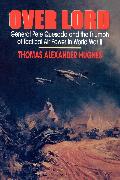- Start
- Overlord
Overlord
Angebote / Angebote:
Over Lord" is the fascinating story of how American tactical air power was developed by General Elwood "Pete" Quesada during World War II, including its decisive role in Operation OVERLORD and the liberation of Europe.Pete Quesada is one of World War II's unsung yet crucial heroes. With his famous "Ninth Tactical Air Command, " Quesada established the best air-ground team in the European theater. he pioneered the use of radar in close air support operations, introducing weapons systems specifically geared to tactical operations. He nurtured new flying methods designed for the kind of precision bombing the battlefields of Europe demanded. And more than anything else, Pete Quesada championed efforts to model air and ground officers into a single fighting unit. His relationships with ground leaders like Generals Omar Bradley and "Lightning Joe" Collins were a model for the kind of interservice harmony that was essential for dislodging the entrenched German Army.At war's end everybody from General of the Army Dwight Eisenhower to ordinary infantrymen recognized Pete Quesada as the premier expert and dogged patron of close air support. Allied airplanes over the battlefields of Europe had undoubtedly shortened the war and saved many thousands of lives, and Pete Quesada came home to a hero's welcome in 1945. By then he was the personification of tactical air power. Indeed, he was its over lord.Unfortunately, Quesada's groundbreaking methods were all but forgotten after the war. As the Cold War deepened, Air Force leaders stressed the role of big bombers flying deep into enemy territory and renounced the importance of close air support missions. Quesada himself was shunted into jobs that were both illsuited to his fiery temperament and divorced from his wartime expertise in tactical aviation. Frustrated, he retired from the Air Force in 1951 at forty-seven years of age.Fortunately, the story of Quesada's innovative tactics did not end there for the American military. In Korea in the 1950s and Vietnam in the 1960s, U.S. servicemen struggled -- and died -- relearning and recreating the kinds of tactics that Quesada had made commonplace in 1944-45. Had the U.S. Air Force nurtured its capacity for close air support, those two conflicts may have unfolded differently. Since then, the Air Force has struggled for a better balance between its bombardment missions and its support functions.This is the definitive story of an extraordinary man, whose remarkable efforts to aid foot soldiers in World War II contributed significantly to the Allies' success. America's belated rediscovery of Quesada's precepts some forty years later in conflicts like Operation DESERT STORM only underscores the importance of Quesada's story.
Folgt in ca. 10 Arbeitstagen
